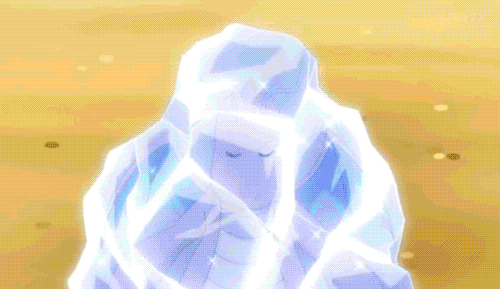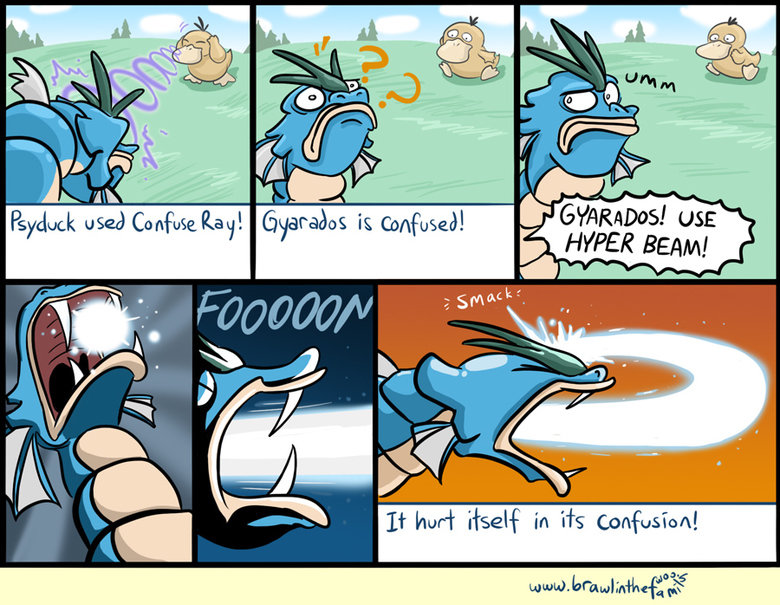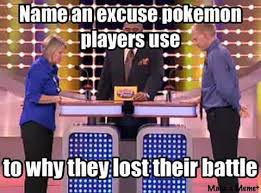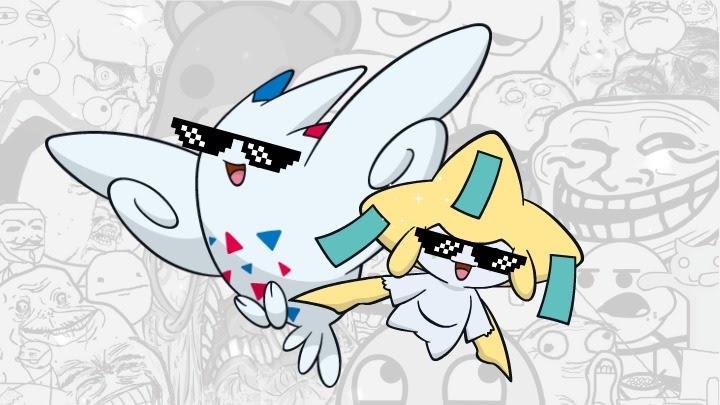“Hax” and luck in Pokémon Battling
Learn the basics on manipulating hax in your favour the next time you battle someone!
“The generation of random numbers is too important to be left up to chance” – Robert Coveyou
Random Number Generators, known for the remainder of this article as RNG, have been a thing since the dawn of humanity, and were thrown into video games as soon as developers could figure out where to put them. These add a chance aspect to any situation, be it a loot drop, monster encounter, or more relevantly a critical hit. Pokémon, being a video game entirely about encountering and engaging different monsters in glorious combat, has made full use of this mechanic for 20 long and miss-filled years.
Unfortunately, RNG has become so ingrained into the game that players have simply taken to calling it “hax”, which is a shortened form of “hacks” to jokingly imply that the opponent is hacking to cause them this bad luck. In this article, I will be examining the luck required in Pokémon’s combat situations, how it works, and how to manipulate it to make your opponents cry tears of pain and suffering. A word of warning: this will be a very technical analysis. We shall explore when RNG has significance in order of occurrence within a turn of a Pokémon battle.
Speed is Like a Box Of Chocolates (Speed Ties)
This one is pretty self-explanatory. According to GameFAQs user Mantine84, if two Pokémon using moves of equal Priority with the same effective Speed stat, “the RNG goes first.” Basically, who moves first each turn is random, and that can turn the tide of a game. It’s effectively a coin toss every single turn.
Assorted Musings On Smogon’s Bans and Focus Miss (Accuracy/Evasion)
Focus Blast has been lovingly dubbed by the community as “Focus Miss”, due to the fact that its 70% accuracy usually feels more like 30%. Double Team and the other Evasion boosting moves have been forever banished from Smogon’s competitive play, an honor shared only by Moody (which has a chance of raising Evasion), Swagger (which will be mentioned later) and Mega Rayquaza (who is a dragon with overwhelming power in the Singles format). Why is this, you might ask? Because Smogonites fear RNGesus, the hypothetical controller of all things luck.
Seriously, it is because evading an attack reduces the attack’s damage output to the same as the amount of health points your poor Ledyba has after taking a Dragon Ascent to the face, which is to say 0.
First, we look at accuracy. After an attack is fired off and before damage is dealt, the game performs an accuracy check (EXCEPTION: when using auto-hit moves like Aerial Ace, Aura Sphere, or Thunder in rain, this check is ignored). If the check has failed, the move misses and has no effect, none of the other checks are performed, and the game informs you of the outcome. The chance that your attack passes the trial of fate set before it is calculated by a formula that looks something like
P = Abase * Accuracy * Evasion,
where Abase is the base accuracy of the move, and accuracy and evasion represent the modifiers from moves like Hone Claws or Double Team, respectively. If P (the chance to hit) is greater than or equal to 100, your moves are always going to hit. So unless your opponent has spammed Minimize, you are going to hit that Scald without a problem, whereas that Thunder you put on your Mega Gardevoir just to hit any obnoxious Talonflame switch-ins still will miss 30% of the time (outside of rain, obviously).
Enter Double Team and its partners in crime, Minimize and Acupressure. Minimize is the most vile offender, reliably raising the user’s Evasion by 2 stages. Double Team is far more well known, because while Minimize raises Evasion by an extra stage, it has only 13 legal users to Double Team’s 703 legal users. That’s right, nearly every TM-compatible Pokémon gets Double Team. The increased stages change the value of Accuracy and Evasion in the above equation, changing them to a value of…

So, if a Pokémon with +1 Accuracy (from Hone Claws) attacks a Pokémon with +4 Evasion (double Minimize) with a move with a base accuracy of 100 in a 6th Generation game, the chance it hits is:
P = 100 * (4/3) * (3/7) = ~57%
This means that if the move were used an infinite number of times, the average damage output would have to be multiplied by 0.57, because the other .43 all result in no damage dealt. How should this impact your decision making? Naturally you could conclude that one should always use Aura Sphere rather than Focus Blast…
…Or not. The average power output of a move is equal to its power times its accuracy, divided by 100. So while Aura Sphere has an average power of 801.0=80, Focus Blast has an average power of 1200.7/100=84.
But alas, averages are great in theory, but in practice RNG still will have its way, possibly causing you to miss your Thunder on that pesky Talonflame only for it to wreak havoc and brutally murder your entire team… Again.
But That SHOULD Have KOed Him… (Min/Max)
![]()
That is the basic damage formula that has been used since Gen 1. Obviously there are some variables; else Tackle and Dragon Ascent would do the same amount of damage. Level is the attacker’s level, Attack is the appropriate attacking stat of the attacker, Defense is the appropriate defensive stat of the defender, and Base is the base power of the move. The Modifier variable has its own formula, which looks something like…
![]()
In this formula, STAB is the Same Type Attack Bonus, Type is the type effectiveness, and other is anything that isn’t otherwise accounted for. However, the remaining two numbers are where we start to see some RNG. (Critical Hits will be discussed at a later time.) The last multiple, the one that many players don’t know exists, is a semi-random value picked by the game between .85 and 1, inclusive. Any result is rounded down, so there are 16 total values it can pick from. However, this often is the difference between a one hit knock-out and a two hit knock-out.
For example, if a Lv100 Sceptile with maximum Special Attack is fighting a Lv100 Swampert with Maximum SpDef and HP and it uses Giga Drain, it will deal damage equal to one of 16 values between 360 and 424. Max HP Swampert has 404 HP, so to get the one hit knock-out, Sceptile needs to do damage equal to or greater than 404. Inconveniently for our Grass-typed meme-busting hero, only 5 of the 16 choices meet this condition, leaving Swampert with health to spare 68.9% of the time. In this case it doesn’t matter too much because Swampert can’t do anything meaningful to Sceptile and Swampert never runs max SpDef, but you get when this could affect play, right? The good folk over at Pokémon Showdown usually refer to this as Min/Max, especially when a move that looks like it could 2HKO after the first attack fails to do so. Rather annoying to say the least.
Hit the Weak Spot for Massive Damage! (Critical Hits)

The concept of a lucky attack on an enemy vital point for extra bonus damage has been around as long as the tabletop RPG has (a really long time). Pokémon has taken full advantage of this feature since the very beginning to screw over unknowing or unlucky trainers and their Pokémon.
I hesitate to call Gen 1’s Critical hit mechanics well designed. They were confusing and incredibly biased. Unlike in newer versions, the extra bonus damage in Gen 1 was a scaling multiplier. This multiplier was approximately (2L+5)/(L+5), where L is the level of the Pokémon scoring the critical hit. This means it scaled with level from 7/6 damage to nearly double damage. However, the really obnoxious thing was the trigger rate, which also had its own formula. The formula was the user’s base speed divided by 512 (48 in the case of Slash and variations). This meant that Alakazam, who already did way too much damage, had a 25% chance to crit with every attack. Fast Pokémon with access to moves like Slash (such as Persian and Dugtrio) further exploited this mechanic.
Generation 2 brought the mechanics up to speed with current logic, but with slightly different numbers. Critical damage was a flat 2X multiplier. It also introduced temporary “stages” for battle much like every other stat. The chance to get a critical hit varied from 1/16 with no boosts to ½ with 4 or more boosts. Moves with high crit ratios started out at +2, Focus Energy provided a +1 boost.
After Gen 2, future changes were negligible. Gen 3 made criticals ignore an enemy’s buffed Defense or SpDef and any reduction in your appropriate attacking stat. Gen 4 introduced the abilities Super Luck, which increases the user’s crit rate by 1 stage, and Sniper, which multiplies critical damage by an additional 1.5X. Gen 4 also reduced Slash and variants to only have 1 increased stage at base, while increasing Focus Energy’s effect to provide a +2. Gen 5 changed… nothing.
And so, we arrive at the present. Gen 6 introduced more changes to the crit formula. Most noticeably, it reduced the damage multiplier from getting a critical to a measly 1.5X. It also changed how the stages work, with the ½ chance being moved to +2 and leaving anything at +3 or above with a guaranteed critical. Omega Ruby and Alpha Sapphire also introduced the most shocking change in the history of the critical hit by changing the color of the confirmation message to yellow. Seriously though, criticals are the most dramatic and impactful luck-related flair in the franchise, and no one will get through their life as a Pokémon player without getting brutally murdered by an untimely critical hit at least once. No one.
If at First Scald doesn’t KO… (Secondary Effects and Special Conditions)
And at last, we reach what happens AFTER the attack. These are your secondary effects, which range from lowering an enemy stat, to forcing them not to attack, to poisoning them. For the time being, we only care about the last two, since cases such as Shadow Ball’s chance to lower the enemy SpDef so rarely matters.
Apparently, a Pokémon flinching prevents them from attacking at all, which seems perfectly logical with the move Fake Out causing the target to flinch. The other moves that cause flinching are slightly less logical, as flinching is most certainly not my reaction to being run over by a Steamroller attack. Regardless, assuming you move before the target, causing them to flinch results that character dealing 100% less damage for that turn.
What moves cause flinching? Fake Out is the most notorious due to the fact that it automatically makes you move first and has a 100% chance to cause a flinch, but it can only be used the first turn the user is on the field. Other moves that cause obvious physical contact such as Headbutt, Crunch, and Stomp (and Steamroller for reasons) also cause flinching. Flinch rates are usually either 20% or 30% at face value, although the elemental fangs have a 10% rate.
The other secondary effects often mindlessly thrown onto attacks are special/status conditions (they are the same thing). These include: poison, burn, paralysis, confusion, sleep, or freezing. The chance appropriate moves inflict these effects range from 6.67% (Tri-Attack for each ailment it can inflict) to as high as 40% (and a few 100% chances here and there). Poison and burn are just flat damage (and an attack reduction on the part of burn), with the recipient losing 1/8th of their health every turn, so we don’t care about them for the purposes of this paper. What you need to know is that many Poison and Fire type moves respectively cause these conditions. The other four all have further luck shenanigans, so onward we go.
Sleep and freeze are similar, so let’s start there. Sleep generally cannot be inflicted by an attacking move, while freezing happens only as a possible (10%) side effect of being hit with every meaningful Ice type move that isn’t Freeze Shock or Ice Burn. (Incidentally, both of these moves normally paralyze and burn respectively in the games, but were both used to freeze members of the Swords of Justice in the 15th Pokémon movie… somehow.) Anyway, being asleep or frozen both prevent the target from moving until they either wake up or thaw out. Waking up happens after some value between 1 and 5 turns, shorter if you have the Early Bird ability. Freezing, since gen 2, has had a 20% chance to thaw out every turn, or an auto-thaw when hit with most Fire type moves or Scald. This could result in your Pokémon being frozen for a hypothetically infinite number of turns, although the chances of this are low. Just be thankful that this isn’t Gen 1, where Pokémon could not ever un-freeze without an Ice Heal or a Fire type move to the face, or the anime, where basically every Ice attack is guaranteed to freeze and Iris’ Dragonite can just let itself get frozen, then get bored and break out of the ice whenever he feels like it because he is Iris’ freaking Dragonite.

Entering a state of confusion is not fun. Once your Pokémon is confused, 50% of the time it will decide to not attack and instead smack itself in the head, dealing damage based on the confused Pokémon’s Attack stat, including all boosts. Swagger naturally boosts the damage self-inflicted given it also greatly boost’s the target’s Attack stat.

Luckily, this wears off after 1-4 turns under most circumstances and can be instantly cured by retreating to the Bench (or in the case of the topic at hand, switching out). All confusion-inducing attacks have some drawback, being either a low rate of the confusion occurring (e.g. Psybeam’s 10%), a chance to miss (e.g. Dynamic Punch’s 50%), raising your opponent’s stats (Swagger boosting the enemy Attack), or multiple of the above (Hurricane misses 30% of the time and confuses 30% of the times it hits, which maths out to 21%). Outrage, Thrash, and the like also confuse the user as a tradeoff for their high base power.
And then we reach paralysis. A paralyzed Pokémon has its speed quartered and a 25% chance of becoming “fully paralyzed” for the turn and not acting. This obviously means that the average damage output of an attack is decreased by 25% (as those are all 0s). Also, Electric types are immune to it. It is caused by basically every Electric attack ever, and it is the most abused form of straight hax in this game. Why is this, you might ask?
Assorted Musings On Serenity and Scope Lens (RNG Abuse)

Now we come to the crux of the article: WHAT DOES ANY OF THIS MEAN? Well, it impacts move choice first of all, and it allows some super cool combos to be made to just wreck house and cause your opponents a large amount of pain and suffering.
When choosing between moves for your Pokémon, you need to weigh the risks and rewards of each choice before selecting your fate. There are a series of calculations that can be performed to determine the exact chance of a OHKO or whatever. For now I shall look at my personal favorite comparison, the powerful Special Water-type attacks that basically every (non-Magikarp/Feebas) Water type gets. Specifically, I refer to Hydro Pump, Surf, and Scald. Surf is the most reliable of the three and the one I used in most situations prior to gen 5. It has a base power of 90 with no additional effects. Scald had a reduced base power of 80, but a nifty 30% chance to burn the opponent. Hydro Pump has a whopping 110 base power, but only 80% accuracy. Imagine a Max SpAtk Kyogre is fighting a fully offensive Mega Mawile outside of rain for some unknown reason. Hydro Pump has a chance to get the OHKO of 63.75% after accuracy and critical hits are factored in, whilst Surf and Scald have a 6.25% chance.
But wait, there’s more (isn’t there always). With residual damage like entry hazards, the calculations get more confusing. With three layers of Spikes on Mawile’s side, the damage Mawile took switching in changes the factored numbers. Hydro Pump’s modified KO chance becomes 80%, Surf’s becomes 100%, and Scald’s changes to 56.3% Scald gets its case without residual damage, as a Burned Mawile cannot OHKO Kyogre back on a miss. So while Hydro Pump may have seemed initially like the best option for this matchup, further investigation reveals that Surf is better if you know you can keep up your entry hazards.
The other place you can control the RNG is to manipulate secondary effects, particularly those that flinch or add an extra chance to crit. There are two main flinch abusers, Jirachi and Togekiss. They share the ability Serene Grace and access to a 30% flinch move (Iron Head and Air Slash, respectively). Serene Grace doubles the chance of added effects happening, meaning that becomes 60%. Add in the fact that both of them have access to Thunder Wave and other moves that paralyze their foe (like Body Slam having a 60% chance to paralyze after Serene Grace), and the enemy will often be attacking only 15% of the time. If you somehow manage to stack confusion on the back of this mess… forget about it. This is SUPER FUN for you and hell for your opponents.
Lastly, critical hits are fun to play with as well. Due to the fact that Gen 6 made going up 3 stages in critical chance correspond to a 100% chance for a critical, there are many ways to get this number. The lamest is Farfetch’d. It has unique access to the item Stick, which boost its critical rate by 2 stages. Add in Slash, Night Slash, or whatever, and nothing will escape your wrath. Absol can run a slightly more viable crit build, with the item Scope Lens and its Super Luck ability combining to have the same effect as a Stick. Lastly, Kingdra can really use this, as a Focus Energy and Scope Lens means it gets the +3 needed to crit with any attack, and its Sniper ability multiplies crit damage by an additional 1.5x for tons of awesome destruction.
In conclusion, RNG can sometimes be annoying, but with a little preparation can be used to turn the tide of the battle in your favor.
Edited by bobandbill, Jake, Lycanthropy and wolf.
Cover image by Etherion.
